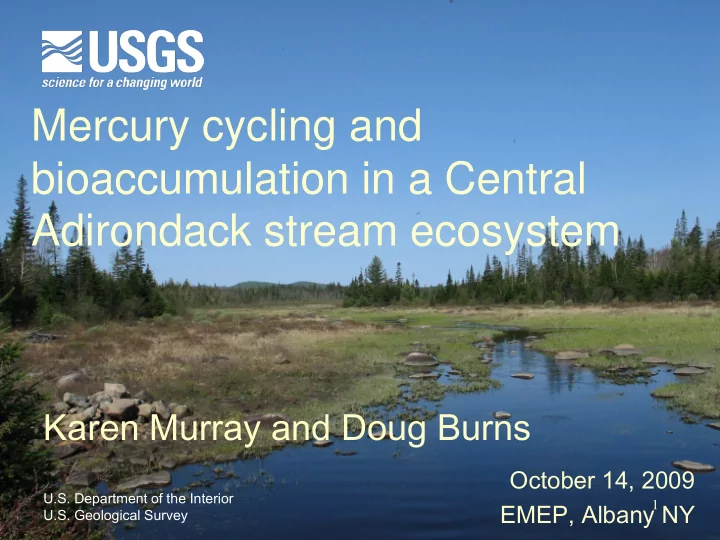

Mercury cycling and bioaccumulation in a Central Adirondack stream ecosystem Karen Murray and Doug Burns October 14, 2009 U.S. Department of the Interior EMEP, Albany NY 1 U.S. Geological Survey
Presentation outline • Background - Mercury cycle in aquatic ecosystems • Mercury in streams across the US (NAWQA mercury studies) • Intensive research on a Central Adirondack stream 2
Acknowledgments Mark Brigham , USGS, MN Water Science Center Lia Chasar, USGS, FL Water Science Center Barb Scudder, USGS, WI Water Science Center Adirondack Ecological Center (Huntington Wildlife Forest) Nature Conservancy, Finch-Paper Co, RMK Timberland 3
Atmospheric Aquatic mercury cycle sources Point sources Methylation Hg ++ MeHg MeHg MeHg Biomagnification MeHg 4
Key questions • How does mercury move from source to fish & other organisms? • How does mercury vary geographically among stream fish? • What controls mercury concentrations in stream biota?
National stream study Scudder et al. 2009 • Game fish, water, sediment • 291 streams across the US • Variety of landscapes • 1998-2005 • Methylmercury & Total mercury in water & bed sediment • Total mercury in game fish 6
Mercury in Game Fish Scudder and others, 2009 7
How does mercury move from source to fish? 8 streams Different settings Single reach Intensively sampled ES&T: Water, sediment Brigham et al. 2008 Complete food web Chasar et al. 2008 Marvin-DiPasquale et al. 2008 8
Key findings • Runoff of methylmercury produced in watershed (wetlands) – Water quality (DOC, pH) • Source versus methylation – Modest source with high methylation – Large source with low methylation • Biomagnification – Similar among ecosystems – Methylmercury in the water determines methylmercury in fish ES&T: Brigham et al. 2008, Chasar et al. 2008, Marvin-DiPasquale et al. 2008 9
Intensive watershed studies 2007-2009 • Where is meHg produced in the watershed? • How / when is it transported to the stream? • What controls its bioaccumulation? 10
Intensive watershed studies 2007-2009 • Forested catchments; atmospheric deposition primary source • Multiple sites sampled throughout small catchments • Fishing Brook (Hudson R basin, NY) • McTier Creek (Edisto R basin, SC) 11
Fishing Brook study area • Central Adirondacks • Upper Hudson R. basin • Near MDN site at HWF • 26mi 2 area • 89% forest • 8% wetland • <3% open water 12
Fishing Brook sites 12 sites overall Range of characteristics Bio collected @ 9 sites Gage at outlet 13
Approach • Sample seasonally 2007-09 • Sample biota from 9 sites • Collect invertebrates & fish representing multiple feeding groups • Analyze for MeHg, THg, d 13 C, d 15 N • Analyze water for MeHg, THg, DOC, sulfate, pH, & more 14
Hg in top predator fish Hg in top predators all HDSN & SANT sites 0.8 Hg (ppm wet weight) 0.6 0.4 0.30 guideline 0.2 n = 26 n = 23 0.0 HDSN SANT Study Unit Includes Hudson R & Edisto R samples
Methylmercury in invertebrates – all sites Mercury Concentrations in Invertebrates All HDSN Samples 1000 MeHg ug/g dry weight Mercury Concentration (ng/g dw) 100 N = 61 N = 12 N = 16 10 N = 36 1 Scraper Omnivore Predator Shredder Shredder Scraper Omnivore Predator 16
MeHg Spatial patterns Creek chub Darner dragonflies 17
Spatial patterns in fish Creek chub blacknose dace
Factors influencing Hg in stream biota logHg ng/g dw inverts fish Hg ng/g dw sh sc om pr shredders cs cc % wetland Feeding level R 2 0.60 p < 0.0001 R 2 0.60 p<0.0001
Mercury in Fishing Brook biota as a function of feeding level & % wetland log MeHg ng/g dw Observed Adj R2 0.85 p <0.0001 Predicted Log Hg ng/g dw
Summary & Conclusions • Streams vary widely in mercury in biota across a relatively small (<30 mi 2 ) area • Mercury in biota of Central Adirondack streams are strongly linked to riparian wetlands • Recovery is expected to be highly variable • There is a need for monitoring of multiple media & multiple organisms in variety of settings
Further information Karen R Murray krmurray@usgs.gov 518-285-5617 Douglas A Burns daburns@usgs.gov 518-285-5662 http://water.usgs.gov/nawqa/mercury 22
Recommend
More recommend